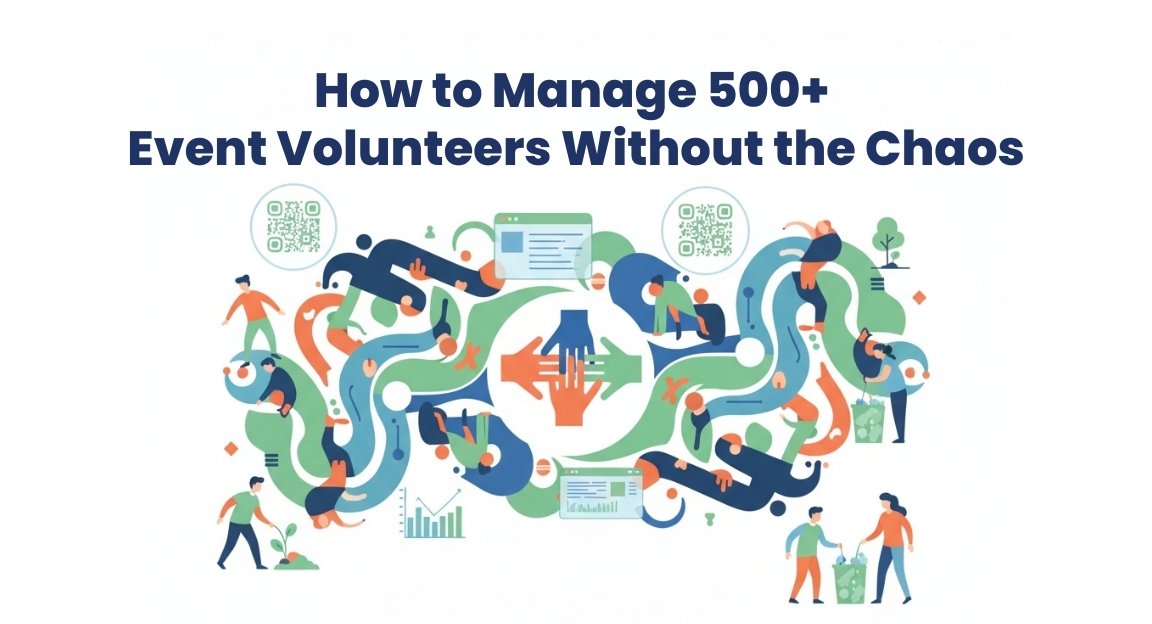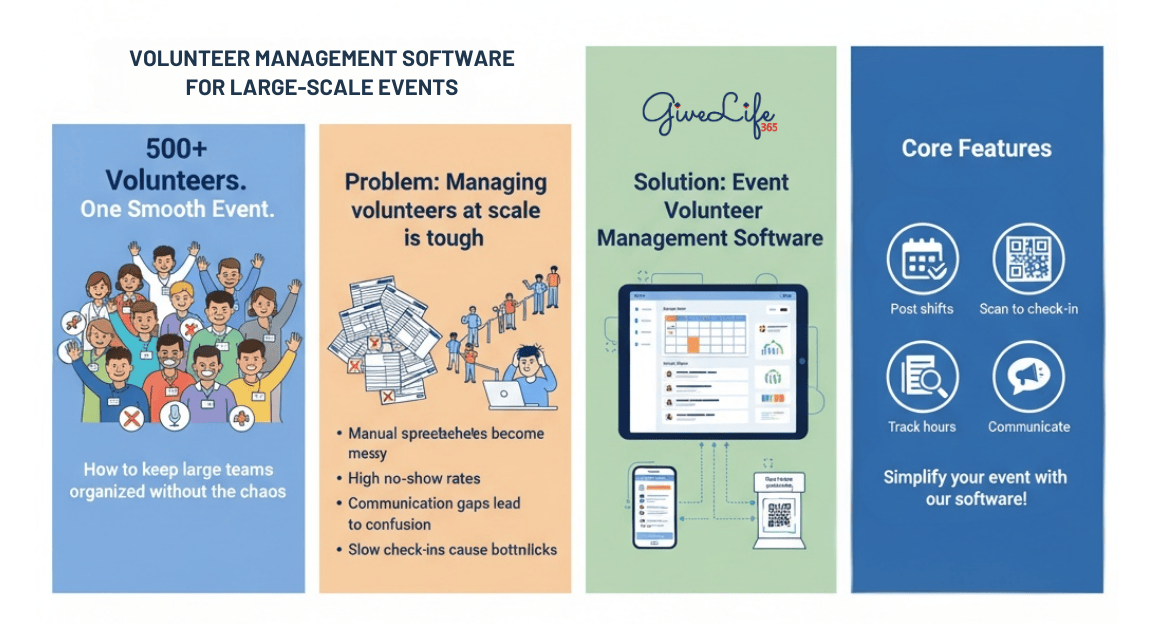

⏰ 8 minutes read
Big events are fun. They're also messy. You've got hundreds of volunteers, sometimes five hundred or more, spread across multiple shifts, locations and roles. If you're running this with spreadsheets and frantic texts? Forget it. You'll burn out before lunch.
That's where event volunteer management software comes in. Not as some flashy add-on, but as the difference between "organized event" and "total meltdown." Let's walk through how the right setup actually makes 500+ people feel manageable.
Publish Roles and Shifts in Minutes
Picture this: you've got 50 different jobs to fill, each with multiple time slots. Instead of sending out one giant email and waiting for chaos to ensue, you just publish it. Roles and shifts are live in minutes. Volunteers see what's open, pick what works for them and boom, it's off your plate.
This isn't just about convenience. It's about giving volunteers agency. When people can choose their own assignments, they're more invested. They show up ready to work because they picked something that actually interests them. Plus, you eliminate that back-and-forth dance of "Can you work Saturday morning?" "No, but Sunday afternoon works." They self-select, and you move on to bigger problems.
Speed Up Check-In with QR Codes or Kiosks
Lines at check-in kill energy fast. Nobody wants to stand in the sun waiting to sign a sheet of paper. QR codes or a kiosk fix this instantly. Volunteers scan, tap and walk right in. Hours track automatically too, so no one has to guess later how long they served.
The beauty of automated check-in goes beyond just speed. It eliminates human error completely. No more illegible handwriting. No more "Wait, did I sign in?" confusion. Everything's digital, timestamped, and accurate. Your volunteers get to their assignments faster and your data stays clean.
Bulk Scheduling in a Few Clicks
Need to assign 200 people across six sites? Normally, that's a nightmare. With bulk scheduling tools, it's a few clicks. Done. You can literally cover a citywide event in the time it used to take to shuffle one Excel tab.
Smart Assignment Logic: Advanced volunteer management software doesn't just randomly assign people. It considers skills, preferences, availability and past performance. The system learns what works and suggests optimal matches.
Geographic Distribution: For multi-location events, the software can automatically balance assignments based on volunteer addresses, ensuring fair travel distances and avoiding overcrowding at popular sites.
Skill-Based Matching: Got volunteers with specific certifications or experience? The system flags these automatically, making sure your CPR-certified volunteers end up at health stations, not parking duty.
Fill No-Shows Automatically
Someone always bails. That's reality. But if your system auto-fills from a waitlist, those gaps close before you even notice. No more scrambling last-minute to beg someone to cover. Every station stays staffed, and you stay sane.
The automation goes deeper than simple substitutions. Smart systems can predict no-show patterns based on historical data, weather, or even local events. They'll automatically overbook certain shifts or send gentle reminders to volunteers with poor attendance records. It's like having a crystal ball for volunteer management.
Link Service Hours to Impact
Volunteers don't just want to clock in, they want to know what their work added up to. Link hours directly to results: 600 meals served, 120 trees planted, 75 families reached. Suddenly, it's not "I worked three hours." It's "I helped feed 50 people." That hits different.
Real-Time Impact Tracking: The best systems don't wait until after the event to calculate impact. Volunteers can see their contribution growing throughout the day. It's incredibly motivating to watch those numbers climb as you work.
Personal Impact Reports: After the event, volunteers receive personalized reports showing exactly how their hours translated into outcomes. These aren't generic thank-you emails. They're data-driven proof of personal contribution.
Cumulative Achievement: For repeat volunteers, the system tracks lifetime impact across multiple events. Seeing "You've contributed to serving 2,000 meals this year" builds long-term engagement like nothing else.
Recognize and Celebrate Service
Here's the thing, retention isn't about free pizza. Recognition is huge. Digital badges, milestone shout-outs, small ways to say, "Hey, we saw what you did." That kind of acknowledgment builds loyalty faster than another t-shirt.
Micro-Recognition Systems: Don't wait for annual awards. Celebrate small wins immediately. First-time volunteers get welcome badges. Five-event veterans get loyalty recognition. Top performers get leadership badges. These digital achievements create a game-like experience that keeps people coming back.
Peer Recognition: Let volunteers nominate each other for outstanding service. When recognition comes from peers, not just organizers, it carries extra weight. Plus, it builds community among your volunteer base.
Social Sharing Integration: Make it easy for volunteers to share their service achievements on social media. When they post about their volunteer badges or impact reports, they're not just celebrating, they're recruiting future volunteers for you.
Track Attendance in Real Time
Event managers need to know what's happening right now. Who checked in? Where are the gaps? How many hours logged so far? A live dashboard answers all of that without chasing down site leads or flipping through notes. And yes, you can export it into a neat report later.
Predictive Analytics: Advanced dashboards don't just show what's happening now, they predict what's coming next. Based on check-in patterns, weather updates, and historical data, the system can forecast potential staffing challenges hours before they happen.
Mobile Command Center: Event managers aren't chained to a desk. Mobile apps let you monitor the entire operation from anywhere on-site. Get alerts when stations are understaffed, see which volunteers are running late, and reassign people on the fly.
Communication Integration: When the dashboard spots a problem, it doesn't just alert you, it can automatically send targeted messages to available volunteers, post updates to coordination channels, or trigger backup protocols.
Streamline Communication Across All Channels
With hundreds of volunteers, communication becomes a logistical nightmare without proper systems. Event volunteer management software centralizes all communication, sending targeted messages to specific groups, roles, or shifts. No more mass emails that don't apply to everyone.
Segmented Messaging: Need to update parking volunteers about a route change? Send targeted messages only to that group. Weather delay affects morning shifts? Alert just those volunteers. This precision reduces noise and ensures important information reaches the right people.
Multi-Channel Delivery: People check different platforms. The system can simultaneously send messages via email, SMS, push notifications, and in-app alerts, ensuring nobody misses critical updates regardless of their preferred communication method.
Two-Way Communication: Volunteers can respond to messages, ask questions, or report issues directly through the platform. This creates a real-time feedback loop that helps managers address problems before they escalate.
Generate Comprehensive Post-Event Reports
After the chaos settles, you need data. How many total hours were served? Which roles had the highest no-show rates? What was the volunteer satisfaction score? Automated reporting gives you these insights without manually calculating anything.
Financial Impact Analysis: Convert volunteer hours into monetary value using standard rates. Suddenly, your event didn't just engage 500+ volunteers, it generated $50,000 worth of community service. That's powerful data for grant applications and board presentations.
Volunteer Retention Insights: The system tracks which volunteers return for future events and identifies patterns. Maybe volunteers assigned to certain roles are more likely to return. Or perhaps volunteers who receive recognition within 48 hours show higher retention rates.
Operational Efficiency Metrics: Compare check-in times, average shift completion rates, and task efficiency across different management approaches. This data helps you optimize future events and demonstrate continuous improvement.

The Bottom Line: From Chaos to Control
Managing large-scale volunteer events doesn't have to be a stress-inducing nightmare. The right volunteer management platform transforms what used to be dozens of manual processes into automated, streamlined operations. You spend less time on logistics and more time on what matters: creating meaningful experiences for volunteers and maximizing impact for your cause.
When volunteers can easily sign up, check in seamlessly, see their impact clearly, and feel genuinely appreciated, they become your biggest advocates. They don't just return for future events, they bring friends. That's how you build a sustainable volunteer community that grows stronger with each event.
The technology exists. The benefits are clear. The only question is: are you ready to transform your volunteer management from survival mode to success mode?
Ready to streamline your next big event? GiveLife365 offers comprehensive volunteer management solutions designed specifically for large-scale events. From automated scheduling to real-time tracking, we help you manage hundreds of volunteers with confidence. Book a Demo to learn more, or reach out for a personalized consultation. Let's make your next event your smoothest yet.
